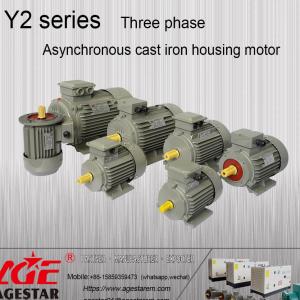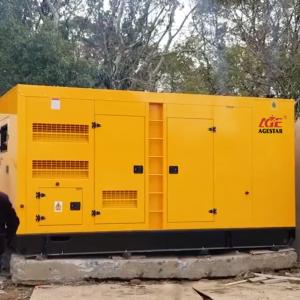Methods and tricks for disassembling and assembling motors (I)
It is often necessary to disassemble the motor when overhauling it. Improper disassembly will damage the motor. Therefore, the motor maintenance personnel must master the technology of correct disassembly and assembly of the motor.
The following steps should be followed when disassembling the motor:
1. Remove all external wiring and mark each wire end, especially the wire end with polarity (DC motor).
2. Remove the pulley or coupling, and record the distance between the coupling and the shaft table.
3. Remove the commutator side end cover and bearing cover screws, and open the end cover.
4. Open the ventilation window of the end cover on the side of the commutator, take out the brush from the brush holder, remove the wire connected to the brush rod and mark it.
5. Before removing the end cover on the commutator side, mark the joint between the end cover and the base, then pad a wooden board, and evenly knock the edge of the end cover with a hammer to make the end cover lip slowly separate from the base and bearing outer ring. Then mark the position of the brush holder and take out the brush holder.
6. Wrap the commutator with thick paper or cloth to keep the commutator clean and avoid bruises.
7. Remove the end cap screws on the shaft extension side, pull the armature together with the end cap out of the stator core, and be careful not to damage the armature winding during operation.
8. To replace the bearing, remove the bearing screws on the shaft extension side and remove the bearing outer cover, end cover and bearing.
9. All removed parts and components shall be placed and stored in the disassembly order to avoid loss and facilitate easy assembly.
10. When assembling the motor, the operation steps are opposite to those during disassembly. Just reset the parts and wiring according to the marks.
The disassembly methods and steps of pulley or coupling are as follows:
1. First loosen the fixing screw on the pulley or coupling or knock down the pin, and add kerosene into the contact joint between the inner hole of the pulley or coupling and the rotating shaft for penetration lubrication. Then slowly pull out the pulley or coupling with a special grab puller (also known as a drawing die), as shown in figure (a). When using the shaft puller, the center of the screw should be aligned with the center line of the rotating shaft, and pay attention to the stress of the pulley or coupling. Do not break the insulation of the pulley or damage the shaft puller.
2. If the pulley or coupling is installed tightly or rusted, and it is difficult to remove, wrap the rotating shaft with a wet cloth, and use a blowtorch to heat the pulley or coupling quickly and evenly to make it expand, and then pull it out and remove it.
3. Alternatively, a square iron with wedge-shaped ends can be used to support the inner ring of the pulley or coupling in an oblique direction, as shown in figure (b). Knock the other end of the square iron with a small hammer to remove the pulley or coupling.
If it is not necessary to clean the bearing or shaft sleeve of the motor, it is not necessary to disassemble the coupling.
There are two methods to install belt pulley or coupling: cold installation and hot installation:
During cold installation, align the keyway or stop screw hole first. For small and medium-sized motors, place wooden blocks on the end face of the pulley or coupling and slowly tap in with a hammer. If it is difficult to knock in, put a wooden block on the other end of the shaft and put it on the wall, and then knock in the pulley or coupling. For large motors, a jack can be used to press the pulley or coupling into the shaft. However, the other end of the motor and the bottom of the jack should be supported by a fixed support frame.
Heat suit refers to heating the interference fit pulley or coupling to make it expand to a certain extent, and then quickly cover it on the rotating shaft. Because the hole and shaft of pulley or coupling mostly adopt interference fit to transmit torque.
The heating methods of the hot suit include oven heating and hot oil cooking:
1. When heating in the oven, place the pulley or coupling in the oven. In order to heat it evenly, the temperature rise speed should be 60 ℃ /h, and the temperature rise should not be too fast. The heating time depends on the expansion amount. It can be tested with the prepared sample needle with the required expanded inner diameter. When the sample needle can extend into the inner hole, the hot sleeve can be carried out.
2. When boiling with hot oil, install a support frame in the oil tank containing transformer oil, place the pulley or coupling on the support, and then heat the oil to make the pulley or coupling heat up and expand, and take advantage of the situation to heat sleeve. In order to prevent uneven heating, the pulley or coupling cannot be in direct contact with the bottom plate of the oil tank.
The disassembly methods of motor brush holder, hood and blade are as follows:
1. For enclosed motors, after removing the pulley or coupling, unscrew the screws of the outer hood and remove the hood. Then unscrew the set screw on the fan at the tail end of the rotor shaft or take out the pin, gently tap around the fan with a wooden hammer, and the fan can be loosened and removed.
2. For wound motor, loosen the brush holder spring, lift the brush holder to remove the brush, and then remove the brush holder. To ensure accurate reset during assembly, make marks before disassembly.
3. For small motors, the fan does not need to be removed, but is drawn out with the rotor. When the bearing in the end cover needs to be greased or replaced, the fan should be removed
4. The removal method of the fan blade shall vary with the installation method
Some wind blades are fixed with clamping screws, some with supporting screws, and some with pins. There are two square holes on the new plastic fan blade, which are used for inserting and disassembling the two pullers of the shaft puller into the holes. Two threaded holes are specially drilled near the shaft on the fan blade of large motors for alternately screwing in two screws corresponding to the holes to push out the fan blade. The fan blades of large motors are tightly installed and difficult to remove. Therefore, when disassembling the blade, carefully observe the fixing method of the blade, and then take corresponding disassembly measures.
三相电机缺相的原因和保护措施
Phase failure operation of three-phase motor refers to the lack of one phase of three-phase power supply in the stator winding of the motor. When the motor lacks a phase, if the motor is powered on and started, the motor will generally make a "buzzing" sound, and the speed rise of the motor is relatively slow. When the load dragged by the motor is relatively heavy, the specified speed cannot be reached when starting, or even cannot be started. If this state continues for a long time, the motor will overheat due to long-term high current, and will smoke, catch fire and burn out in serious cases.
If there is a sudden lack of one phase during the operation of the three-phase asynchronous motor, the speed of the motor will soon decrease, and the current of the motor stator winding will also increase a lot at this time. At the same time, it will make an abnormal sound of "buzzing". In this case, the motor cannot run for a long time, otherwise the three-phase motor will be burned out.
Generally speaking, the causes of phase loss of three-phase motor can be divided into two types: external and internal:
External reasons for phase loss of three-phase motor: in a large number of maintenance cases, it is common that the wiring screws in the motor junction box are loose; Secondly, the connection points in the three-phase power supply circuit are loose or oxidized, such as poor contact or large contact resistance of some contactors, resulting in phase loss of the power supply; Also, the fuse in the fuse is disconnected or not firmly connected.
Internal causes of phase loss of three-phase motor: internal causes are generally rare, generally due to the broken outgoing line of three-phase motor. At this time, we can measure the DC resistance of the three-phase winding. If the resistance of one phase is large or infinite, then the winding is the open phase. If the three-phase resistance is basically balanced, the cause of the motor can be eliminated.
The phase failure operation of three-phase motor is very harmful to the motor. We can take some protective measures to protect the three-phase motor during phase failure operation. For example, the thermal relay with open phase protection can be used for open phase protection, and the thermal relay with two pole or three-stage structure can be used for open phase protection when the stator winding is connected into Y-type; If the stator winding of the motor is connected into a triangle, we can only use the three-stage thermal relay with open phase protection device, so as to realize open phase protection.





